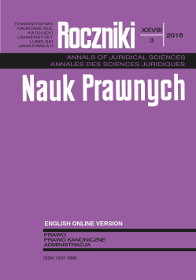The Origin of the Polish National Loan Fund and Its Operation on the Polish Lands
The Origin of the Polish National Loan Fund and Its Operation on the Polish Lands
Author(s): Eliza Komierzyńska-OrlińskaSubject(s): Law, Constitution, Jurisprudence, History of Law, Commercial Law
Published by: Towarzystwo Naukowe KUL & Katolicki Uniwersytet Lubelski Jana Pawła II
Keywords: issuing bank; central bank; currency reform; monetary system
Summary/Abstract: The idea of establishing the Bank of Poland as the central bank of the Second Polish Republic and introducing a new currency appeared shortly after Poland regained its independence. At the beginning of 1919, in the economic circles it was believed that one of the initial steps taken by the government would be to establish a new issuing bank in place of the Polish National Loan Fund, which had appeared on the Polish territory in an emergency situation—during the First World War, and which, contrary to the original (both German and Polish) plans survived for 7 years and was transformed after the war into the first bank of issue in the now independent Polish State.The Polish National Loan Fund established by the Germans as an issuing institution by way of the ordinance of December 9, 1916 establishing the Polnische Landes Darlehnskasse was granted the privilege of issuing a new currency, that is a new monetary unit under the name marka polska. The German authorities were guided by various objectives when creating the new issuing institution—first of all, the aim was to limit the area of circulation of the German mark and to create an instrument that would draw in the occupied area of the Polish territory to finance the war, contrary to the assurances of the occupying authorities that the PKKP would be an institution supporting the economy and banking system of the country—the Kingdom of Poland, whose creation was envisaged after the end of World War I.
Journal: Roczniki Nauk Prawnych
- Issue Year: 28/2018
- Issue No: 3EV
- Page Range: 45-69
- Page Count: 25
- Language: English

